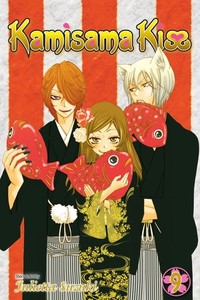Review
by Rebecca Silverman,Kamisama Kiss
GN 9 & 10
| Synopsis: |  |
||
After the gathering of the kami, Nanami heads home, although she does make a stop in Kyoto to visit Kayako, the human kami. Things don't settle down once she returns to her shrine, however, as a small tengu comes in search of his lost idol, Shinjuro, the heir to the tengu title of Sojobo. Since the current Sojobo is ill and Jiro, the tengu in line, is a violent thug, the little tengu wants Shinjuro to return to the mountain with him. So of course Nanami and Tomoe have to tag along... |
|||
| Review: | |||
What do Black Bird and Kamisama Kiss have in common? Why, tengu of course! These two volumes in Julietta Suzuki's girl to goddess story are mostly concerned with the happenings at Kurama's home village, an enclave of male tengu forbidden to women. The leader of the clan, who bears the title of Sojobo, has fallen ill and the other tengu fear for his health. They are also concerned because with the disappearance of Sojobo's son Shinjuro seventeen years ago, the next man in line is Jiro, who has spent his life working under the doctrine of “survival of the fittest” and firmly believes in ruling with not only an iron fist, but one studded with spikes for good measure. The youngest tengu fear him, and so Botanmaru leaves the mountain in search of Shinjuro. Shinjuro, however, isn't sold on the idea of returning – he has a life in the human world, thank you very much. He is concerned, though, and so with Nanami (who couldn't resist this chance to help) and Tomoe (who won't leave Nanami alone) in tow, he accompanies Botanmaru back to the mountain. The highlight of this storyline is, without a doubt, Nanami's powers. She goes to the tengu enclave supplied with blank white ofuda, and she uses them with more finesse and skill than we have heretofore seen. The way she overcomes the villain is breathtaking and serves to showcase her skill, smarts, and good heart, making the climax of volume ten one of the best of the series so far. Likewise her compassion is on display here, particularly in her interactions with Botanmaru. Serving as a foil to this is Jiro, the vicious tengu who covets the title of Sojobo. We see his harshness with tiny tengu Daidai within pages of Nanami's kindness towards Botanmaru, allowing Suzuki to make her point admirably. The brutality with which she shows Jiro acting also helps to quickly establish his character, making it all the more impressive when Nanami begins to bring about changes. The greatest weakness of the tengu arc is one which has emerged before in earlier volumes – with Nanami as the sole female character in the tengu village, there begins to be a distinct sense of reverse harem. The tengu village is, as has been mentioned, all male, so Nanami is the first woman most of them have seen. Whether or not this justifies half the cast developing amorous feelings is up to you, and Suzuki does make it work in the end, but there are a few chapters in the middle that feel more like QuinRose's Alice series than the story we've been reading. On the subject of romance, people who have been reading for it will be very pleased with these two volumes. The romantic subplot between Tomoe and Nanami begins to move in a very big way, with other characters gently (or not) guiding the characters in the direction we want to see them go. A chapter in which her school friends invite Nanami on a group date is especially good for this, as is Nanami's effect on the tengu. Seeing the elegant Tomoe get ever more ruffled and jealous is certainly amusing. The only real downside to this increase in romance is a decrease in Mizuki's page time, although he is present in snake form for much of the books. Suzuki's art remains attractive and with some very nice touches. Nanami in disguise does look fairly significantly different, but perhaps the best artistic flourish is the way that Suzuki gives all of the tengu dark eyeliner, even the younger ones, and when they use their tengu powers, their noses get longer. While in general the tengu are less varied in appearance than the other creatures, they are still distinct, although not nearly as visually interesting as the new bad guy, introduced in volume 9. Suzuki does appear to be building towards a specific event with this character (and Kirihito), which certainly bodes well for the rest of the series. Kamisama Kiss is nothing if not consistent, and this set of books continues its entertaining, charming, and sometimes funny story. With an upcoming anime version, it seems that this series is getting the positive attention it deserves. Despite a few reverse harem issues and Jiro's expanding and contracting scars, this remains a delightful read and a great way to while away a few hours. |
|
The views and opinions expressed in this article are solely those of the author(s) and do not necessarily represent the views of Anime News Network, its employees, owners, or sponsors.
|
| Grade: | |||
Overall : A-
Story : A-
Art : A-
+ Nanami's powers get shown off, real development on the romance front. Good artistic choices for tengu and a promising villain. |
|||
| discuss this in the forum (6 posts) | | |||
| Production Info: | ||
|
Full encyclopedia details about Release information about |
||